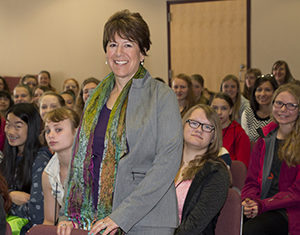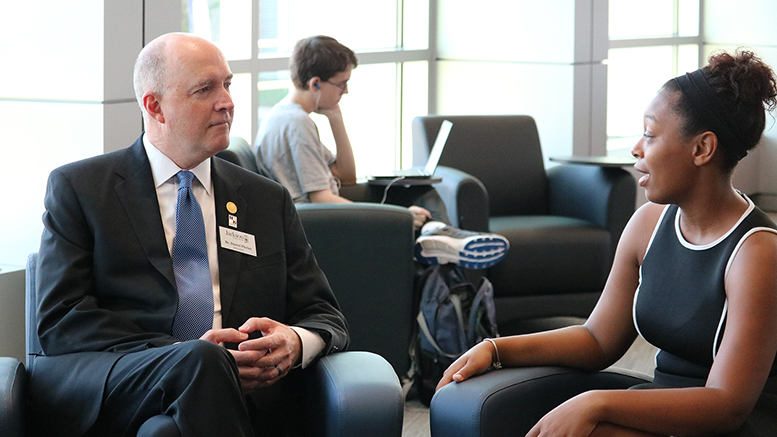These days, a growing number of community college presidents stay at their institution for five or six years before moving on, but leadership experts observe that presidents who stay a decade or longer typically make lasting improvements in student success.
The current board chair of the American Association of Community Colleges (AACC) and two previous AACC board chairs – all of whom have served their colleges for about 16 years – will share how they stay fresh and passionate about their work at a session during the AACC Annual Convention in New Orleans April 22-25.
Mary Spilde, who headed the board in 2009-10, says maintaining a “very active engagement in the life of the college and the real work of the college” has helped her stay energized as president of Lane Community College in Oregon.
“These jobs are way more complex than when I started 16 years ago,” says Spilde, who plans to retire in June. Budgeting, accountability and accreditation have become more complicated, as funding has shrunk and new demands have been placed on community colleges. But those parts of the job are just a means to an end.
“Engaging students and faculty is what’s really important to me,” says Spilde, who enjoys talking with students about what makes them successful.
Lane is part of the Achieving the Dream (ATD) network of colleges, and Spilde finds “learning about where we go next with ATD and student success strategies is very energizing. That goes to the core mission and the heart of what we do.”
She also finds that teaching in a doctoral program at Oregon State University for future community college leaders “keeps me alive in my work” as a president.
Transforming strategies
At Lane, Spilde promotes professional development as a strategy for transforming the institution. She developed a year-long program for faculty and other staff interested in advancing in their careers. It begins and ends with a retreat and covers academics, equity, technology, the budget and all other aspects involved in running a community college.
Facilitating the retreats “gives me a connection with faculty and staff who are working directly with students, and that allows me to see the college from a different viewpoint,” Spilde says. “And I get to nurture their leadership skills, which keeps me interested, excited and connected to the broader college.”
The program is open to all staff. Two custodians participated last term, and they gained a better understanding of how their jobs – which involve providing a clean and beautiful environment – contribute to student learning, Spilde says.
“I made a long-term commitment to Lane when I took the job,” she says. “I wanted to stay until I retire; I didn’t see it as a stepping stone.”
Building relationships
Jane Karas has had a long tenure at Flathead Valley Community College (FVCC) in Montana – a couple of years as a vice president before being named president in 2001 – because “I love the community, the students and faculty,” she says. “I have a great board. It’s been a great fit.”
“Having been here for long time, I’ve been able to build positive relationships with business and industry,” says Karas, who served as chair of the AACC board of directors in 2013-14.

Jane Karas, president of Flathead Valley Community College in Montana, says that successful colleges have consistent leadership. (Photo: FVCC)
It’s a challenging job, but keeping energized is critical to the college’s success, Karas says. She keeps the commitment alive by continually finding ways to engage with students and faculty, connecting with the community and learning how the college can better meet the community’s needs. Strategic thinking and planning are integrated into everything she does.
Among the changes during her presidency: FVCC doubled in size; many new programs were added, including a study abroad initiative; and partnerships with K-12 schools and four-year institutions have expanded. At FVCC, “we focused on how we can meet the needs of our students and ensure they can succeed in a global economy,” Karas says. And that means providing more education and training opportunities and more support services.
Colleges that have implemented solid improvements have had consistent leadership seeing them through, Karas says, adding that it’s not enough just to make a change and leave.
“It’s all about building relationships,” she says. “The more time you have at a college, the stronger those relationships can be.”
A covenant with the board
A new president who plans to stay for the long term needs to start by establishing a good relationship with the board, says Daniel Phelan, who served as president of Southeastern Community College in Iowa for about 14 years before becoming president of Jackson College in Michigan in 2001.
“To keep yourself and your institution fresh, you need to have the latitude to take risks and to fail sometimes,” says Phelan, who is the current AACC board chair. That means developing “a covenant with the board to effectuate change that is sustainable in the long term” and encourages the board and president to support one another through good times and bad.
Courageous leadership: The American community college requires bold, new leadership in transforming and sustaining institutions. This year’s pre-AACC convention sessions includes a workshop designed for leaders who aspire to succeed as courageous and inclusive senior executives. Register today for the AACC convention April 22-25 in New Orleans.
But it takes time for the board and president to trust one another enough so they can “weather through the difficulties and take risks,” he says.
“In most cases, if you’re not going to be around for seven to 10 years, it’s best not to make any big changes,” Phelan says. “Quick fixes aren’t going to be successful in the long term.”
He notes that the presidents of community colleges that have won the Aspen Prize have been in their positions for at least 10 years. “These are presidents who’ve been toiling in the fields of cultural development and have a long-term vision of what the culture should be,” he says.
Changing the culture
Understanding the culture of the college is critical, Phelan says. “It’s a multifaceted beast,” incorporating the college’s values, mores, problems, failures and hopes – everything from the impact of budget woes to enrollment traumas and union issues.

Lane Community College President Mary Spilde (center) walks in the City of Eugene’s Parade of Champions. (Photo: LCC)
According to Phelan, it takes seven to 10 years to change the culture of an organization.
“Once you’ve assessed what the culture is, it takes time to figure out what is the preferred culture,” Phelan says, “and all groups need to be in agreement about what that is.”
Once that happens, the college must develop strategies and steps to move that forward, Phelan says, which could mean changes in staffing, budgeting and other key areas.
At Jackson, the preferred culture was determined to be “total commitment to student success” (abbreviated as TCS2). Several reforms have been implemented, including career pathways, a new approach to hiring and professional development, and an overhauled student advising system, Phelan notes. The college also established a clear set of beliefs spelling out “what we stand for and what we aspire to be.”
Building a team
Jackson College implemented new procedures within its human resources department to ensure the college was intentional about hiring people who support the culture of student success. The college’s leadership council interviews every job candidate “to make sure they fit into our preferred culture,” Phelan says.
During new employees’ first week, they have lunch with the leadership council, meet the key players and visit all campuses. At the end of the week, if they don’t think they fit into the culture, Phelan says, “we give them $1,000 and help them find another job.” If they stay, they revisit with the leadership council in about a year to see if it’s still a good fit.
Phelan’s relationship with his board of trustees is also carefully crafted.
“We have an incredible relationship with our board. It’s a highly functioning policy governance board,” he says. “There is a lot of collaborative thinking, planning and envisioning what our future should be. We are in lock step on this.”
He adds: “As a leader, you have to be consistent in the message and consistent in action, and the board has to be as well. You have to talk about this early and often.”
Phelan advises new presidents – and the boards to which they report – to start with the idea that this will be a long-term relationship. “Don’t go in thinking it will be just two or three years.”
Many boards say they want a president “to lead us to the future.” Phelan urges candidates for the presidency to have deep discussions with the board about “What do you want the future to look like? And will you support me if we go in that direction?”
Surviving a vote of no confidence: A vote of no confidence needn’t be a kiss of death anymore for a college president.



